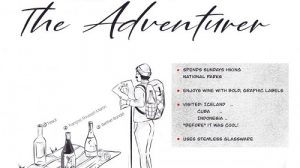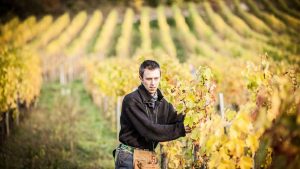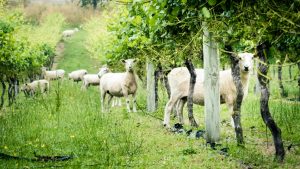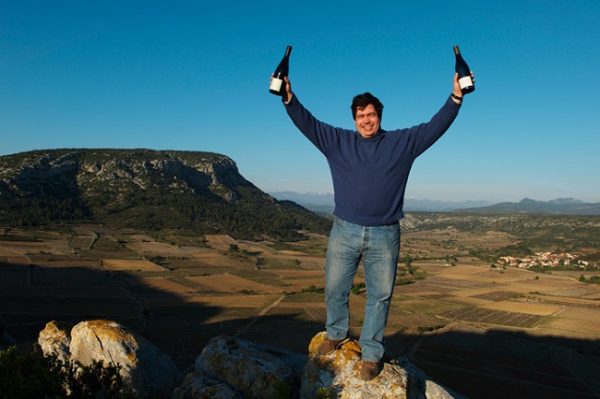
Tucked away in the undulating Roussillon countryside, Clos des Fées is making waves in the world of French fine wines. We cast our attention to the estate’s owner, Hervé Bizeul, a former sommelier and journalist – for the French speakers among you, he regularly updates the domain’s blog – who wields his pen as he does his grapes: with precision and accuracy. The results are staggering.
Before settling down amid the vines, walls and soil of the Clos des Fées, Hervé Bizeul’s peregrinations had been many, flitting around the wine business and the world in general. As a sommelier, as a journalist… but most of all, as a son of this hard ground, with real pride in Roussillon. It was one day in 1997, looking out onto this desert of scrubland, with its dry-stone walls and vines planted in pick-hacked holes amid the green oaks with their twisted branches, that he decided to take his passion for wine to its logical extreme by becoming a wine grower himself. Thanks to his hard work in the vines – but also through his formidable enthusiasm for selling and promoting his wine with a talent for forging links that is somewhat uncommon among growers, who enjoy the solitary company of their vines and can be uneasy with commercial relationships – Bizeul would be quick to find success.
Returning to the landscape of his birth, this Perpignan native began his viticultural education. But as the material did not cover the style of win he wished to create, he left after only two days. This was a man with a vision! Now it was time to start the serious work of making wine from his old vines. Looking back on this time, the winemaker admits that he started out with “staggering naïvity”. He produced his first wine using rudimentary fashion by pressing the grapes using chesse cloth fabric before vinifying the juice in a friend’s winery. But it paid off as Hervé Bizeul pre-sold the wines before they were even ready to be released in 1999. IT was a miracle that allowed him to continue this venture and to construct a mini-winery equipped with stainless-steel vats.
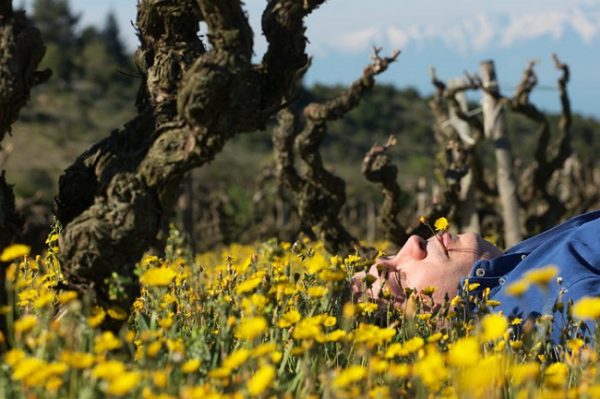
Convinced that he could craft fine wine from this spectacular terroir, Hervé Bizeul spent much time reflecting and observing how he could do this. The answer for him was to use the specific characteristics of his plot located in the village of Vingrau in the Pyrenees and to use methods from centuries ago. He ploughs his vineyard to rejuvenate the soil, bans chemicals, using minute quantities of synthetic products when necessary.
Now in his well-equipped winery, Hervé Bizeul adopts the same philosophy. He strives to allow the identity of the terroir to shine through in the wines so he only invests in what is absolutely necessary for crafting his fine wines such as a temperature controller for during vinification, an efficient destemmer and a good pump.
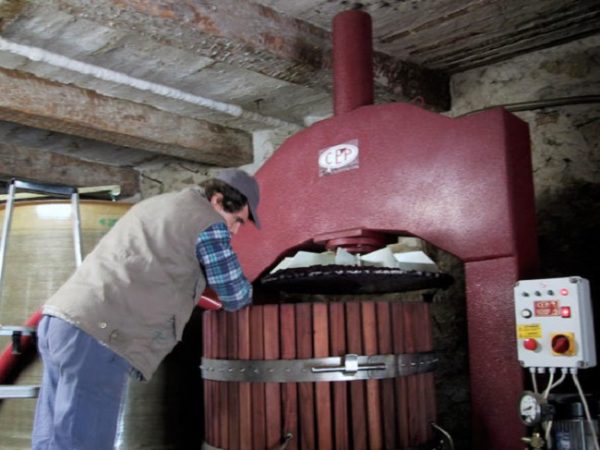
“Why the Roussillon?”, some wine lovers may ask. While it’s undoubtedly very beautiful, this region is known for its sometimes-harsh climate and poor soil. So much work for so few grapes! But Hervé Bizeul has learned to work with his surroundings. He is extremely free in his choice of varietals and grows Syrah, Cabernet Sauvignon, Cabernet Franc, Pinot Noir and Tempranillo.
Where does his energy and creativity come from? It is clear that his career as sommelier and his passion for writing have led him to truly putting what he wants to achieve with his wine in words and taste. La Petite Sibérie is an example of his wines which people fight over in our auctions. Like the domain, its creation was somewhat by accident. In 2001, four years after Clos des Fées was created, Hervé Bizeul harvested the grapes from this small parcel last, only to find that he had no vats left in which to ferment the grapes! He proceeded to make the wine in plastic containers. Despite these conditions, the resulting wine showed unparalleled texture, complexity and length. A grand Grand Cru, some might say! In addition to this excellent cellaring wine, his range includes easy-drinking wines such as Les Sorcières, out-of-the-ordinary wines such as Images Dérisoires produced from Tempranillo, and Un Faune avec son fifre produced with Cabernet Franc.
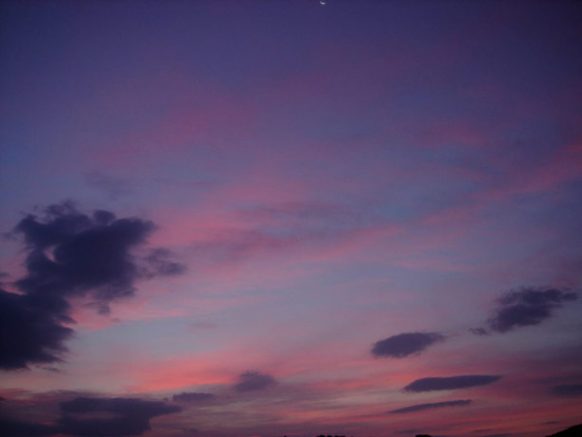
What the guides say about Clos des Fées
La Revue du vin de France’s Guide Vert
An unmissable producer in Roussillon whose wines retain the natural expression of the grapes and are aged without much intervention.
Bettane+Desseauve: 3 stars out of 5
Hervé Bizeul no longer has anything to prove: this domain is well and truly part of the Roussillon elite. This hasn’t stopped him from always challenging himself, trying new ideas, and creating new cuvées. We’re betting that he won’t stop there.
Wines from Clos des Fées currently on sale on iDealwine
Côtes du Roussillon Clos des Fées
“Clos des Fées” is the domain’s finest cuvée: the most ambitious, the richest, the one which should be aged longest and opened on a special occasion! This cuvée is produced from a blend of old vines (between 70 and 100 years old) of Syrah, Grenache, Carignan and Mourvèdre. A mosaic of small parcels which are meticulously harvested (the grapes are transported in refrigerated vans!), specialist vinification, some of which in demi-muids and the rest in stainless steel vats, followed by an élevage of 18 months in stainless steel vats. This exceptional wine will not leave you indifferent.
Côtes du Roussillon Clos des Fées La Petite Sibérie
A single 1.16 hectare plot is devoted to one of the property’s finest cuvées, the sublime, almost legendary “Petite Sibérie”. The old Grenache Noir vines grow in somewhat extreme conditions on a clay-limestone base, covered with schist with an exceptionally high iron content. The plot is exposed to an icy wind for more than 200 days of the year, hence its name, “Little Siberia”. The wine is topped up regularly with a blend of Mourvèdre and Syrah, and then bottled without filtration. A superb, dense, complex wines that needs at least 15 years to reveal its potential.
IGP Pyrénées Orientales Clos des Fées Un Faune avec son Fifre
This cuvée from Clos des Fées is poetically labelled “Un faune avec son fifre sous les oliviers sauvages” (faun with fife under the wild olive trees). It is produced predominantly from massal-selection Cabernet Franc. The nose offers up aromas of ripe red fruits, red pepper and some delicate hints of spice, while the flavours of dark fruits and liquorice dominate on the deliciously powerful but balanced palate. This excellent wine pairs very well with Mediterranean style meat dishes.
Côtes du Roussillon Clos des Fées Vieilles Vignes
“Vieilles Vignes” is without doubt the property’s most representative wine, which gives an indication of the potential of Vingrau’s terroir, and of the winegrower working it. If you want to know what the two together are capable of, this should be your first choice. It consists of a blend of the property’s oldest vines (from 50 to 100 years old), mainly planted on fine clay-limestone hillsides. The wine is aged in barrels that have held one, two or three wines for 60% of the total volume, and the rest in concrete vats.
IGP Côtes Catalanes Clos des Fées Images Dérisoires
“Images Dérisoires” is a rare, unusual, terribly charming wine. It is the product of Hervé Bizeul’s desire to do something new. In 2005, therefore, he planted a selection of Tinto fino (the local name for Rioja’s emblematic grape variety) sourced from a excellent terroir in Ribeira del Duero (the region of Vega Sicilia, the mythical Spanish wine). The juice from these young wines – the first vintage of which is 2010 – is blended with old Carignan planted shortly after WW2 at a relatively high altitude of 450m. It is completed with a suggestion of Syrah. A totally original blend, but whose Franco-Spanish origins pair perfectly with this arid, mineral Roussillon terroir.
Côtes du Roussillon Clos des Fées Les Sorcières (red)
Les Sorcières is a wonderfully voluptuous, easy-to-drink wine, made from a selection of old vines (80 year-old Grenache and Carignan) and blended with young Syrah and Mourvèdre. The soil is mainly clay-limestone with a few plots of black schist. Altitudes of between 200 and 350 metres. Hervé Bizeul’s objective with this wine is to obtain maximum fruit while preserving freshness with slow, medium extraction. The wine is aged in concrete and stainless steel vats.
Côtes du Roussillon Les Sorcières (white)
A blend of Grenache Blanc, Vermentino, Roussanne and Macabeu, it produces a wine with a pale golden colour. The palate, which is full of fruit flavours, is lively thanks to its freshness and pleasant finish which deliver delicious citrus fruit flavours. This wine also has a red wine sibling.
Côtes du Roussillon De battre mon coeur s’est arrêté
The wine “De battre mon cœur s’est arrêté” (my heart stopped beating in English) is a slightly unusual as it is predominately made from Syrah, which goes against the regional norm. But tasers who have been around for longer than they wish to admit can see the winemaker’s ambition to create a fresher Syrah that could be mistaken for a wne from the Northern Rhône, so it’ll particularly appeal to those who like wines from this region.
Returning soon: IGP Côtes Catalanes Clos des Fées Modeste
This cuvée is aged over fine lees for six months to allow it to develop its aromas and flavour. It has a powerful bouquet with fresh fruit and dried flower notes. The refined palate is fresh and fluid with delicious fruit present throughout. This wine is ideal as an aperitif or as an accompaniment to cured meats or simple grilled meats.

